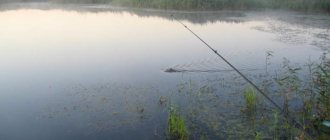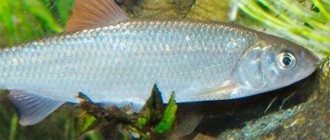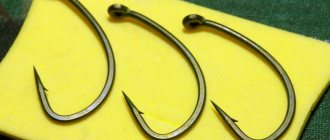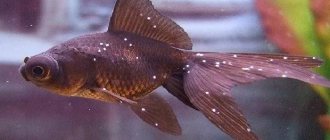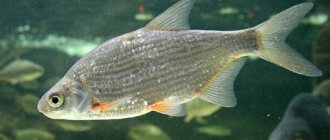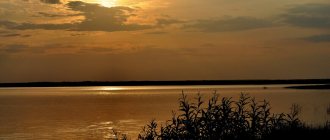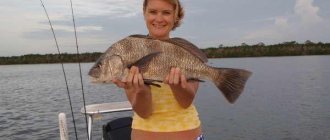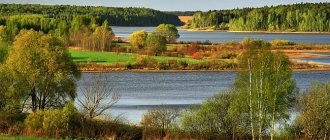- Wild animals
- >>
- Fish
White carp is a large and beautiful fish from the Carp family. It is valued for its beneficial properties. It grows quickly and adapts well to the ecological niches of various fresh water bodies. It is a commercial fish. Possessing excellent taste, it also brings additional benefits to water bodies, effectively clearing them of excess aquatic vegetation on which it feeds.
Origin of the species and description
Photo: White Cupid
Grass carp (Ctenopharyngon idella) belongs to the Carp family, order Cypriniformes, class Bony fish. This species comes from East Asia, where its distribution is still high, starting from the Amur River and reaching the southern Chinese borders.
Video: Grass Cupid
Belamur appeared in Russian rivers under the Soviet Union, when in the early 60s it was introduced and acclimatized to effectively combat abundant aquatic vegetation. It cleans water bodies very effectively, eating up to 2 kg of aquatic plants per 1 kg of its body weight within one day. On average, a large adult individual can eat about 20-30 kg of algae per day.
Interesting fact: Grass carp is able to eat not only underwater plants, but can also eat terrestrial vegetation, for this purpose it goes to places where rivers flood. Cases have been recorded of representatives of the species jumping out of the water to grab land plants.
This species is found in central irrigation canals and ponds used for cooling power plants. In such natural conditions, the fish is not able to spawn, and its reproduction occurs with the help of larvae brought from the Krasnodar Territory and Moldova.
White carp is a useful fish that is bred for commercial purposes. Has excellent taste. The meat is fatty, tasty and dense, white in color, nutritious. The liver of grass carp is also valuable; it is also used for food; the liver is large, with a high fat content.
Planting Density
Stocking density of grass carp and dense planting of natural food is very important. The more vegetation in the pond, the more grass carp should be planted. Productivity depends on the oxygen content in the water and nutrition during its cultivation ranges from 50 – 100 kg/ha.
When in the same pond as common carp, grass carp and carp should not compete for food. Planting grass carp is cost-effective when pond productivity increases. If there is no natural food, the amount of grass carp in the pond should be reduced.
Appearance and features
Photo: Grass carp fish
Grass carp is a fairly large fish, reaching a length of 1.2 m and a weight of up to 40 kg. The body has an elongated valval shape, with some flattening noted on the sides. The head is low, the mouth is set straight, the rear edge of the mouth does not extend beyond the front edge of the eyes in a vertical line. The forehead is very wide.
The teeth are special - pharyngeal, arranged in 2 rows, compressed in the lateral direction, the edge of the teeth is very sharp, can be compared to a saw, with an uneven serrated surface. The scales are large, dense, with a dark stripe located at the very edge of each scale. The scales on the abdomen are light, without a rim. The back and belly between the fins have a rounded shape.
Fins:
- the dorsal fin has a somewhat rounded shape, starts slightly in front of the ventral fins, the fin is high, but not long, has 7 branched rays and 3 unbranched ones;
- pelvic fins do not reach the anus;
- the anal fin has a slightly rounded shape, small size, has 8 branched and 3 unbranched rays;
- the caudal fin is large, its notch is medium.
All fins are light, except for the caudal and dorsal. The back of grass carp is green with a gray tint, the sides are light golden, with 40-47 scales located along the lateral line. Above the gills there is a gill cover, on which stripes diverge radially. Gills with sparse and short stamens. The eyes have a golden iris. Grass carp has 42-46 vertebrae and a dark, almost black peritoneum.
Where does White Cupid live?
Photo: Live grass carp
The natural habitats of the fish are East Asia, namely, from the Amur River and south to Xijiang. In Russia, Amur lives in the river of the same name, its middle and lower reaches. For the purpose of acclimatization, in the 60s of the 20th century, fish were released into many rivers of the USSR.
Among which:
- Don;
- Dnieper;
- Volga;
- Kuban;
- Amur;
- Yenisei and others.
The move-in was carried out with the aim of clearing plant accumulations.
The introduction of fish into freshwater bodies was also carried out:
- North America;
- Europe;
- Asia;
- on Sakhalin.
The main purpose of the introduction is the reproduction of fish as an object for fish farming. It spawns mainly in the Songhua River, Lake Khanka, the Ussuri River, in the rivers of China, on the Don, and on the Volga. Now grass carp lives in almost all reservoirs, large lakes and river-lake systems:
- Moldova;
- European part of Russia;
- Belarus;
- Central Asia;
- Ukraine;
- Kazakhstan.
The presence of fish in rivers, reservoirs and pond farms is ensured only through artificial propagation.
Grass carp - what kind of fish?
The homeland of grass carp is the Far East with its main habitat in the middle and lower reaches of the Amur, including the desalinated shelf of the Sea of Okhotsk. Fierce food competition with numerous representatives of char, salmon, sturgeon, and mullet forced the fish to completely switch to phytofeed, where there were fewer potential competitors: bighead carp (bighead), local forms of bream and chebak, black carp (Chinese roach). The latter is not a species relative of the belamur and forms its own genus (lat. Mylopharyngodon), which is on the verge of extinction in Russia, and in China is intensively bred in artificial fresh water bodies.
What does grass carp look like?
This species is quite easily identified by its non-standard appearance for representatives of the carp family:
- an elongated body of round cross-section (cylinder) with minimally pressed sides;
- small head with a strongly flattened forehead;
- the mouth with fleshy lips is directed downward;
- pectoral fins are placed close to the rear edge of the gill covers, decorated with radial stripes;
- rounded back dark olive or ash gray;
- eyes with golden irises;
- light belly;
- silvery or yellowish sides with large and tightly attached cycloid scales, which are characterized by smoothed edges (40-47 in a row).
In addition, the fish has a very short dorsal fin with 8-10 rays, inferior in size to the anal fin (11). The largest grass carp grows up to 120 cm and weighs 40 kg, but standard catches are dominated by young individuals (3-5 years old) weighing 2-6 kg.
To learn more:
Tench: description of fish, habitats, spawning and fishing methods
What does grass carp eat?
Photo: Grass carp fish
An important condition for the existence of fish is the presence of abundant higher vegetation, since grass carp is a herbivorous fish and feeds exclusively on plants. The food for young grass carp initially consists of zooplankton and small crustaceans. As it grows, upon reaching an intestinal length of 6 to 10 cm, the fish switches to feeding on plants.
Plant food is the main component of the diet, but sometimes individuals of the species can eat young fish. Unpretentiousness to food is the main feature of eating behavior. While in the pond, you can happily eat the food that is designed for carp.
Plant food preferred by grass carp:
- soft grass;
- elodea;
- duckweed;
- thread;
- chilim;
- hornwort;
- pondweed;
- reed leaves;
- sedge;
- hard algae.
It prefers easily accessible food, so it likes the soft stems and pre-cut leaves of reeds. However, when there is no “favorite” food, cupid begins to eat everything, indiscriminately including emergent plants, which it pulls and uproots. He eats some of it, but spits out a lot of it. It can eat beet tops, cabbage leaves, and clover.
The temperature range from 25 to 30° C is best suited for active feeding of carp. The weight of food eaten at this temperature range is up to 120% of its own weight. The digestion process in this species occurs quickly; food passing through the short gastrointestinal tract is not completely absorbed. Very rarely, as an option, it eats insects, leeches, and mollusks.
Interesting fact: In the winter, when the temperature is low and there is not enough, and sometimes no plant food at all, it may not eat at all. This occurs due to the fact that the body has accumulated a supply of nutrients during the period of active nutrition. At the same time, there is a decrease in metabolism and all body functions of individuals.
What does it eat in the pond?
Grass carp can be considered a vegetarian, since the fish eats exclusively plant foods. Young individuals eat zooplankton, and as soon as their intestines lengthen, they switch to algae. However, in artificial growing conditions they do not disdain food intended for carp, and among plants they prefer filamentous grass, soft grass, chara algae, hornwort, duckweed, and reed leaves. The fish do not like the hard stems of the yellow iris, but cut reed leaves, which are easy to get in the water, may well become lunch for the fish described. In cases where there is not enough plant food in the pond, grass mown on the shore is a good choice for feeding grass carp.
Unlike adults, fry are not so harmless and willingly eat insects and small crustaceans that get into the reservoir. Taking this into account, when raising young animals in an aquarium, you can throw ready-made animal food intended for fry of predatory fish into the water.
Features of character and lifestyle
Photo: Grass carp fish
Belamur in its natural habitat migrates depending on seasonal frequency. When it is warm, it is found in the appendages of rivers, and closer to cold weather and during winter it lives in the river bed, where it can gather in flocks in holes in the river bottom.
Grass carp is a stenophage, that is, it uses a definitely narrow range of food for feeding - these are mostly aquatic plants; it can also use terrestrial plants growing on the slopes of rivers and reservoirs. To tear off the plant, it uses its jaws, and with the help of its pharyngeal teeth, the plant fibers are ground. Young animals less than 3 cm can be used to feed on small crustaceans, crustaceans and rotifers.
Sexual maturity occurs at different times in different habitats. So, in its native environment - the Amur River basin, sexual maturity occurs by 10 years. In Chinese rivers a little earlier, by 8-9 years.
Interesting fact: Representatives of the species living in the rivers of Cuba reach sexual maturity very early, at 1-2 years of age.
The eggs are spawned in portions, the spawning is spread out over time:
- in Chinese rivers from April to August;
- in the Amur basin during June and July. Simultaneous spawning is also assumed.
The eggs are pelagic, meaning they float in the water column. 3 days after the eggs are laid, the larvae hatch from them; it is important that the water temperature should not be lower than 20°C. The fry soon move towards the shore, where they have all the necessary conditions, including food - insects, larvae, small crustaceans, algae. After body growth of 3 cm, it switches to feeding on vegetation.
Belamur is not shy, but very cautious. He has places to hide, for example, at the bottom of a river hole or in branches. The routes along which the fish swim are the same. In sunny times it likes to swim in the upper warm layers of the reservoir.
Social structure and reproduction
Photo: Belamur
Adult individuals of this species can gather in schools, this is especially noticeable during wintering, which the fish spend in holes at the bottom of the river.
Interesting fact: During the cold winter season, special skin glands produce a viscous secretion, the whitish threads of which can float in the water, thus revealing places of significant concentration of fish.
After reaching sexual maturity (on average 7 years) in the summer, grass carp goes to spawn. It should be shallow water, with a hard bottom, the base of which is stone or clay. An important condition is the presence of an adequate current and a water temperature of 25°C.
On average, the female spawns about 3.5 thousand eggs, floating in the upper warm layers of water, which then spread with the flow of water. After 3 days, larvae emerge from the eggs.
Within a week, the larva, having previously secured itself on the underwater plants of the reservoir, grows into a fry. The fry, being in the coastal zone, feeds on zooplankton and benthos organisms. When he reaches a height of 3 cm, Malek switches to a vegetarian diet.
Interesting fact: Under unfavorable conditions - lack of food, strong currents, sharp temperature fluctuations, reproduction stops and the eggs are destroyed, the so-called resorption.
Lifestyle and habitats
The indigenous Amur resident has been successfully introduced into the water bodies of the European part of Russia. It is especially numerous in the river systems of the Don, Ural, Kuban, and Volga. The species has a wide range of temperature tolerance and unpretentiousness regarding the oxygen regime. Thanks to historical memory, it thrives in cold water from 0 to +5C, but prefers warm bodies of water (ponds, reservoirs, lakes, irrigation canals) with summer temperatures of +25-30C and above, since such conditions are most favorable for the active development of aquatic vegetation .
What does grass carp eat?
Grass carp is a large herbivorous fish that is capable of eating food at the level of 110-130% of its current weight per day. The constant need for food is explained by the short intestines (no more than half the length of the body), which processes the food eaten too quickly, leaving a constant feeling of hunger. On the other hand, the accelerated functioning of the digestive tract allows for rapid weight gain (1-3 kg per year), which explains its mass commercial introduction into the pond and river culture of Russia.
The basis of the diet of grass carp is plant food, but, like all cyprinids, it can be omnivorous if there is a deficiency of the phyto-feed base. Fish eats:
- Characeae and duckweed;
- filamentous and soft grass;
- reed and hornwort;
- cereals and waste from their processing;
- small crustaceans and worms;
- bloodworms, leeches, insects, mollusks;
- emergent plants and zooplankton.
During the hungry season, it often eats the eggs and larvae of other fish and even begins to chase the fry, so when breeding grass carp, farms practice artificial feeding of the species by regularly throwing mowed soft grass, reed leaves or standard carp feed mixtures into the reservoir.
Habits of grass carp
Food activity persists from April to mid-October. When the water temperature drops to +8-9C in autumn, the fish stops feeding and prepares for the winter, choosing the deepest holes at the bottom of the reservoir. In the warm season, it gathers in large flocks and spends almost all its time among thickets and on plantations with bottom vegetation, filamentous algae, and duckweed. Grass carp can feed in any layer of the reservoir if there is suitable food there.
The fish is not shy, but is quite careful. If there is a suspicious noise, it immediately moves to another section of the reservoir and for a long time ignores the place it does not like.
Spawning
Sexual maturity occurs at 7-9 years with a body length of 60-75 cm, but can naturally accelerate under conditions of abundant nutrition and forced growth. For grass carp to spawn, clean shallow water with a fairly strong current and a hard bottom (stone, pebbles, clay) is necessary. The water temperature should be at least +25-26 C. This is why grass carp spawns later than other species - in June-July.
To learn more:
Ide: description of fish, habitat and lifestyle
An adult female is capable of laying up to 1.5 million pelagic eggs, which rise to the upper layers of water and are carried over long distances by the current. The incubation period of grass carp eggs takes minimal time. After just 1.5-2 days, tiny larvae appear, attach to the plants and continue their development due to the nutritional reserves of the yolk sac. The transformation of a larva into a fry takes no more than a week. A small fish 7-8 mm long moves as close to the shore as possible, where it begins to actively feed on zooplankton and benthos. Having reached a height of 3-4 cm, the white carp fry gradually switches to plant food.
If there are no conditions for a normal spawning process in a reservoir, the fish completely stops reproducing. The resorption mechanism (Latin resorbeo - absorb) is activated in the body of females, and the eggs self-destruct.
Natural enemies of grass cupids
Photo: White Cupid
The adult White Cupid has an impressive size, thanks to which it has no natural enemies in freshwater rivers. But for still small, growing individuals there are many dangers, including:
- unfavorable climatic conditions, sharp temperature fluctuations, changes in flow speed, droughts, floods;
- insects, amphibians, and other animals that can feed on eggs. Considering that not so many eggs are spawned, this may even threaten the existence of the population;
- for small and medium-sized fish, the threat is posed by predator fish, including pike and catfish, only if we are talking about open reservoirs;
- birds living near bodies of water, as well as waterfowl, can feed on small and middle-aged representatives of the species, which also negatively affects the quantitative characteristics of the population;
- a man with his careless and sometimes greedy attitude towards fishing.
Since White Cupid is a very tasty and healthy fish, every fisherman strives to catch it. Environmental problems, unfortunately, appear on an alarming scale. Waters are polluted by waste and discharges from chemical production; to increase benefits, growth factors and hormones are added to feed, changing the entire biocenosis of ecological systems.
How does grass carp spend the winter in a pond?
In open natural reservoirs, grass carp can successfully winter even with significant temperature drops, hibernating in the depressions and unevenness of the bottom. A temperature of +1...+2°C is the most optimal for artificial wintering ponds, in which fish also hibernate. During a long winter (until June), grass carp will live well only with regular feeding, and during this period, no more than 10,000–20,000 fingerlings of fish can be kept in each plot of 1,000 m².
With a responsible approach to the issue of growing grass carp, it is successfully bred even in small private farms, thanks to which regular consumption is possible not only by owners of artificial ponds, but also by visiting fishermen, ensuring high profitability from the fishing business. Of course, breeding such fish cannot be called a problem-free task, but knowing about the peculiarities of its nutrition and the most suitable conditions for keeping it, difficulties and troubles can be minimized.
